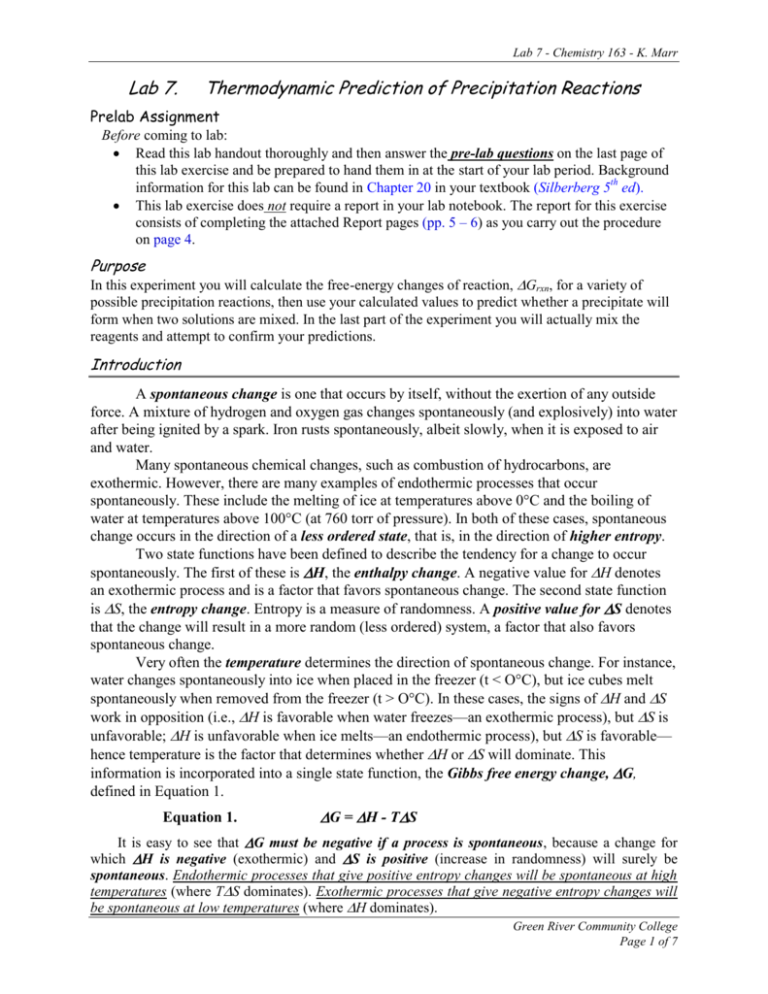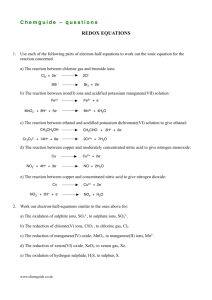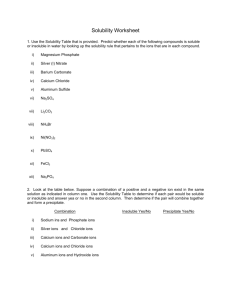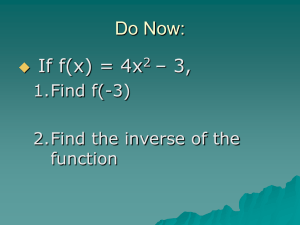Thermodynamic Prediction of Precipitation Reactions
advertisement

Lab 7 - Chemistry 163 - K. Marr Lab 7. Thermodynamic Prediction of Precipitation Reactions Prelab Assignment Before coming to lab: Read this lab handout thoroughly and then answer the pre-lab questions on the last page of this lab exercise and be prepared to hand them in at the start of your lab period. Background information for this lab can be found in Chapter 20 in your textbook (Silberberg 5th ed). This lab exercise does not require a report in your lab notebook. The report for this exercise consists of completing the attached Report pages (pp. 5 – 6) as you carry out the procedure on page 4. Purpose In this experiment you will calculate the free-energy changes of reaction, Grxn, for a variety of possible precipitation reactions, then use your calculated values to predict whether a precipitate will form when two solutions are mixed. In the last part of the experiment you will actually mix the reagents and attempt to confirm your predictions. Introduction A spontaneous change is one that occurs by itself, without the exertion of any outside force. A mixture of hydrogen and oxygen gas changes spontaneously (and explosively) into water after being ignited by a spark. Iron rusts spontaneously, albeit slowly, when it is exposed to air and water. Many spontaneous chemical changes, such as combustion of hydrocarbons, are exothermic. However, there are many examples of endothermic processes that occur spontaneously. These include the melting of ice at temperatures above 0°C and the boiling of water at temperatures above 100°C (at 760 torr of pressure). In both of these cases, spontaneous change occurs in the direction of a less ordered state, that is, in the direction of higher entropy. Two state functions have been defined to describe the tendency for a change to occur spontaneously. The first of these is H, the enthalpy change. A negative value for H denotes an exothermic process and is a factor that favors spontaneous change. The second state function is S, the entropy change. Entropy is a measure of randomness. A positive value for S denotes that the change will result in a more random (less ordered) system, a factor that also favors spontaneous change. Very often the temperature determines the direction of spontaneous change. For instance, water changes spontaneously into ice when placed in the freezer (t < O°C), but ice cubes melt spontaneously when removed from the freezer (t > O°C). In these cases, the signs of H and S work in opposition (i.e., H is favorable when water freezes—an exothermic process), but S is unfavorable; H is unfavorable when ice melts—an endothermic process), but S is favorable— hence temperature is the factor that determines whether H or S will dominate. This information is incorporated into a single state function, the Gibbs free energy change, G, defined in Equation 1. Equation 1. G = H - TS It is easy to see that G must be negative if a process is spontaneous, because a change for which H is negative (exothermic) and S is positive (increase in randomness) will surely be spontaneous. Endothermic processes that give positive entropy changes will be spontaneous at high temperatures (where TS dominates). Exothermic processes that give negative entropy changes will be spontaneous at low temperatures (where H dominates). Green River Community College Page 1 of 7 Lab 7 - Chemistry 163 - K. Marr Many textbooks give tabulations of values for standard free-energy changes of formation (Gof), standard enthalpy changes of formation (Hof), and standard entropies (So). The ―o‖ symbol indicates that the values are for changes involving substances in their standard state, one atmosphere pressure and 298 Kelvin. The ―f‖ subscript on G and H denotes formation; Hence, Gof and Hof are the free-energy and enthalpy change associated with a reaction in which one mole of product is formed from its constituent elements in their standard states, 1 atm and 298 K. Table 1 shows how to use tabulated values of Gof, Hof and So for carbon, oxygen and carbon dioxide to calculate the free energy change in the combustion of carbon. Note that you can obtain the standard free energy change for any reaction, Grxn by subtracting the sum of the Gof for the reactants from the sum of Gof for the products as in Equation 2, below. o Grxn products G of reactan ts G of Equation 2. Table 1. Calculation of the Free Energy Change for the Combustion of Carbon (Graphite) Hof of the reactants and products: Soof the reactants and products: Gof of the reactants and products: Calculation of Horxn: Calculation of Sorxn: Calculation of Gorxn: The combustion of carbon to give carbon dioxide is, of course, a spontaneous process. This is confirmed by the fact that Grxn for the combustion process is -394.4 kJ/mol. This means that when one mole of graphite, the standard form of carbon, is combined with the mole of oxygen to produce one mole of CO2, the free energy of the system decreases by 394.4 kJ. If the reaction is not performed with all materials in their standard states, if the reaction temperature is not 298K, or if more or less than one mole of carbon is consumed in the reaction, then a value of Grxn will differ from Grxn. The relationship between Grxn and Grxn is shown in Equation 3, below. Equation 3. o Grxn = G rxn + 2.303 RT log Q or o Grxn = G rxn + RT ln Q In Equation 3, R is the ideal gas constant (8.314 J/Kmol), and T is the temperature in Kelvin. The symbol ―Q‖ denotes the reaction quotient, defined below. aA + bB cC + dD Green River Community College Page 2 of 7 Lab 7 - Chemistry 163 - K. Marr How to Calculate the Free Energy of a Reaction, Grxn In this experiment, you calculate the Grxn for a variety of possible precipitation reactions. You will use your calculated values to predict whether a precipitate will form when two solutions are mixed. In the last part of the experiment, you will actually mix the reagents and attempt to confirm your predictions. Table 2 lists the data you will use to make your calculations. The following paragraph explains how to use this data. The row and column headings of Table 2 show the standard free energies of formation of the various ions under consideration, with the standard state as a 1 M solution. Thus, Gof for Ag+ is 77.107 kJ/mol and Gof for Cl- is -131.228 kJ/mol. Entries within the body of the table show the standard free energies of formation for the crystalline solids that result from the combinations of the various ions whose rows and columns intersect to create the compound's cell. For instance, Gof for AgCl is -109.789 kJ/mol. The "W 10" entry in the cell corresponding to sodium sulfate indicates that the most likely precipitate is Na2S04.10H2O. When you write the equation for the precipitation of a hydrated salt, water will appear as a reactant. Therefore, in the calculation of Grxn, you will need to consider Gof for water (Gof of water = -237.129). Because you will not be working with 1 M solutions, the free-energy changes you will be calculating will not be standard free energies—therefore, equation 3 will be needed to convert Gorxn to Grxn. See table 3 on page 4 for a sample calculation of the free-energy change, Grxn, for the possible reaction between Ag+ and Cl- to form the precipitate silver chloride, AgCl. Table 2. Gibbs Free Energies (kJ) of formation, Gof, for Ions in 1 M Solution and for Ionic Solids Anions Cations ClINO3SO42-131.228 -51.57 -108.74 -744.53 + Ag -109.789 -66.19 -33.41 -618.41 77.107 Ba2+ -1296.32 W2 -663.9 -796.59 -1362.2 -560.77 + Na -384.138 -286.06 -367.00 -3646.85 W10 -261.905 Ca2+ -748.1 -528.9 -743.07 -1797.28 W2 -553.58 Possible Source of Unexpected Results Take note that we are not considering possible deviations of the ions in solution from ideal behavior—we should be using “activity,” rather than molarity when calculating G values. This omission/error will be most serious when ions of high charge (e.g. divalent ions) are involved. Highly charged ions (e.g. divalent ions) have a higher tendency to form ion pairs in solution than monovalent ions. The formation of ion pairs reduces the concentration of those ions in solution—that is, the formation of ion pairs reduces the ―activity‖ of the ions involved. The term activity is used to explain the deviation in ionic properties of ―real solutions‖ from ―ideal solutions‖ and is related to the concentration and interaction of ions in solution, the more concentrated the solution the more the activity will deviate from the concentration, the difference usually being described in the form of an activity coefficient, i.e. activity = coefficient x concentration. The activity coefficient depends on the identity of the ion and the magnitude of its charge. The activity coefficient equals one for ideal solutions, hence the activity = concentration for ideal solutions. Green River Community College Page 3 of 7 Lab 7 - Chemistry 163 - K. Marr Table 3. Calculation of Gorxn and Grxn for the formation of silver chloride, AgCl, when equal volumes containing silver ions and chloride ions are mixed. Procedure (Work in teams of two to four) Special Equipment and Solutions: 0.20 M Solutions in dropper bottles of Ag+, Ba2+, Na+, Ag+, Ca2+, Cl-, I-, NO3- and SO42Spot plates 1. First calculate the standard free-energy change, Gorxn, and then the free-energy change, Grxn, for each precipitate that might form when each of the 0.20 M solutions of cations listed in table 2 is mixed with an equal volume of each anion solution listed. Record your Grxn values at the top of the appropriate cells in table 4. Sample Calculations: Under question #1 on page 6 record sample calculations of the Gorxnand the Grxn for the possible reaction between sodium ions and sulfate ions and for the possible reaction between barium ions and sulfate ions. Note: The mixing equal volumes of 0.20 M solutions of cations and anions will result in 0.10 M solutions after mixing. 2. Use your Grxn values to predict which combinations will result in a precipitate (ppt) or will not form a precipitate (no ppt). Record your predictions below the Grxn values in table 4. 3. Mix the solutions and record in Table 4….. a. the appearance and formula any precipitate the forms. If no precipitate forms, record N.R. (for no reaction). b. whether your observations support (S) or refute (R) your predictions. 4. On the report sheet and separate paper if needed, discuss possible reasons for any discrepancies between your predictions and your observations. Green River Community College Page 4 of 7 Lab 7 - Chemistry 163 - K. Marr Lab 7 Report Sheet Thermodynamic Prediction of Precipitate Rxns Experimental Results Name Team No. Date Section (Use a pen to record all experimental data and observations.) Table 4. Calculated Grxn values, Predicted Results (ppt = precipitate; NR = no reaction) and Actual Results/Observations for the mixing of equal volumes of 0.20 M cation and anion solutions. S = observations support prediction; R = observations refute prediction Anions Cations Cl- I- NO3- SO42- Ag+ Ba2+ Na+ Ca2+ Green River Community College Page 5 of 7 Lab 7 - Chemistry 163 - K. Marr Analysis of Results 1. In the space below neatly show a sample calculation of the Grxn for the possible reaction between sodium ions and sulfate ions and for the possible reaction between barium ions and sulfate ions. Use correct sig figs and circle your answers. 2. Examine table 4. Are there any discrepancies (“unexpected results”) between the predictions and the experimental observations? If so, explain all discrepancies in as much depth and detail as your knowledge allows. Hint: See “Possible Source of Unexpected Results” on page 3. Record your response in the space below and continue on an additional sheet of paper as needed and staple it to this page. Green River Community College Page 6 of 7 Lab 7 - Chemistry 163 - K. Marr Lab 7. Thermodynamic Prediction of ppt rxns Prelab Questions Name Section ______ Team # ______ Show your work with units and correct significant figures for all questions that involve a calculation. 1. a.) Write the chemical equation corresponding to Gof for AgCl. b.) How does this equation differ from the net ionic equation that shows AgCl precipitating when solutions of Ag+(aq) and Cl-(aq) are mixed? 2. Under what conditions of temperature are endothermic processes spontaneous? Explain 3. The value of Gof for Mg2+ is –454.8 kJ/mol. The value for Gof,298 for MgCl2.6H2O is –2114.64 kJ/mol. Will a precipitate form when 0.20 M Mg2+ is mixed with 0.20 M Cl-? Calculate G for the reaction to determine if a precipitation reaction will occur or not. Green River Community College Page 7 of 7








